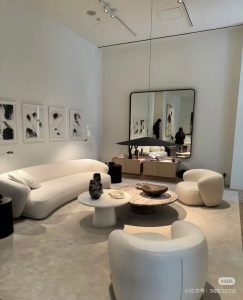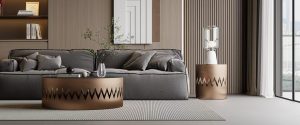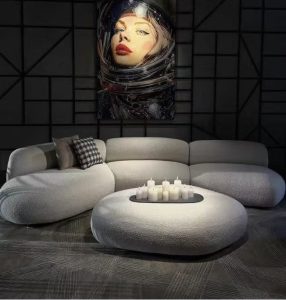Modern furniture takes its roots from early 20th-century ideas like Bauhaus and De Stijl. It loves simple, useful designs. It uses honest materials like wood, steel, and glass. These focus on being strong and looking plain but pretty. On the other hand, contemporary furniture changes with today’s styles. It mixes new materials like recycled plastics and smart fabrics. It aims for eye-catching looks and flexibility. Both types care about being eco-friendly now. Companies like PNA Furniture mix old-school skill with new ideas. They meet people’s needs for quality, beauty, and green design.
Let’s dive into what makes these styles different. We’ll look at their ideas and how they pick materials. PNA Furniture shows how to blend both worlds well.

What Are the Core Differences Between Modern and Contemporary Furniture Styles?
Each style has its own heart. Let’s trace where they come from and what drives them. This helps us see why their materials are so different.
How Did Modern Furniture Evolve From Historical Movements?
Modern furniture began long ago in the early 1900s. Groups like Bauhaus and De Stijl said no to fancy, old-fashioned designs. They liked clear, simple shapes instead. Straight lines and boxy forms became their thing. They focused on making things useful. Every piece had to do its job—no extra fluff. This thinking built a style that still shapes modern furniture today. It loves plain looks, useful shapes, and real materials.
This history makes modern furniture special. It guides how it uses materials and designs. Let’s see how this works.
Why Is Contemporary Furniture Considered More Fluid in Style?
Contemporary furniture moves with the times. It changes as people’s tastes, tech, or lives shift. Unlike modern furniture, which sticks to one era, contemporary stuff evolves fast. What looks contemporary now might not in ten years. It pulls ideas from different times. For example, it might mix 1950s shapes with shiny, futuristic finishes. Or it softens hard, factory-like edges with curvy, natural lines. This freedom lets it fit many tastes and stay fresh.
This ever-changing nature affects material choices. It opens the door to bold, new mixes. We’ll explore this next.
What Philosophies Drive Each Design Approach?
Modern furniture loves clear, purposeful design. It’s simple but smart. It cares about balance, structure, and being useful. Every piece must work well. Contemporary furniture, though, is about showing feelings. It’s bold, sometimes wild, and loves looking cool as much as being useful. A chair might have a weird back just to look interesting, even if it’s not super comfy.
These ideas shape how each style picks materials. Modern sticks to useful ones. Contemporary goes for flashy ones. Let’s look at why materials matter so much in modern designs.
Why Do Material Choices Matter So Much in Modern Design?
Materials are the heart of modern furniture. They show its love for realness and function. Let’s see how natural and factory-made materials make this style shine.
How Do Natural and Industrial Materials Define Modern Pieces?
Modern furniture picks raw materials like wood, leather, steel, and glass. These aren’t just useful—they’re loved for being real. Factory materials like stainless steel or molded plywood aren’t hidden. They’re shown off as they are. PNA Furniture uses 2 or one standard steel for home furniture if customers ask. Other braid standard steel is also available. The top is tempered glass in different colors, natural marble, artificial marble, or wood. These picks show a love for honest, tough materials.
This focus on real stuff ties to modern design’s big ideas. Let’s see how simplicity plays a part.
Why Is Functional Minimalism Central to Modern Design?
In modern design, everything has a job. Nothing extra is added. This makes a clean look where the structure itself is pretty. Joints are shown, not hidden. Welding lines, if seen, are neat. Curves follow the body’s needs, not just for show. Even screw angles are planned to save money and work well. The result is furniture that’s both useful and nice to look at.
This simple approach shapes material picks. It ensures every piece is strong and lasts long. Let’s check out the main materials used.

Which Materials Dominate Modern Furniture Production?
Modern furniture loves strong woods like walnut or oak. Stainless steel frames give toughness. Clear or frosted glass tops add a fancy touch. Natural leather seats are comfy and last long. Now, engineered woods are used more. They’re super tough but still look great. These materials are picked to last forever while staying stylish.
Now, let’s switch to contemporary furniture. How are its material trends different, and what pushes them?
How Are Material Trends Shifting in Contemporary Furniture?
Contemporary furniture thrives on new ideas. It follows what’s hot in culture and tech. It uses daring materials to stand out. Let’s see what drives these changes.
What Cultural & Tech Trends Influence Contemporary Materials?
Contemporary furniture keeps up with big changes. People care about the planet, so recycled plastics are popular. New tech brings smart fabrics. City life needs light, easy-to-move materials. PNA Furniture sees more demand for mixed materials, like their steel-wood combos, in business spaces. These choices show how contemporary furniture stays current and cool.
This quick change leads to fun material mixes. Let’s look at how these shape the look.
How Do Mixed Media & Experimental Finishes Shape Aesthetics?
Contemporary designs love surprising combos. Picture concrete next to soft velvet. Or acrylic mixed with reused wood. These break old rules. Finishes like dull metallics, powdery coatings, or shiny lacquers add wow factor. A great example is PNA’s Contemporary Table Set. It has tempered glass tops with wooden egg-shaped bases. It looks simple but grabs attention.
These bold picks make us wonder: is function still key, or is it all about looks now? Let’s find out.
Does Functionality Still Matter—or Has Expression Taken Over?
Modern design picks materials for how they work. Can they hold weight? Do they age nicely? How do they handle wear? This makes furniture that lasts for years, not just months. PNA’s custom tables and chairs for Fujiya Restaurant were shown on CBS News Sacramento during Restaurant Week 2023. They’re built to last.
Contemporary pieces focus on setting a mood. A chair might have a quirky back just to look cool, even if it’s less comfy. Materials are picked for their feel and color, not just strength. But function still matters a bit—it’s just not the main focus.
How does PNA Furniture mix these two worlds? Let’s see their special way.
How Does One Manufacturer Bridge Both Worlds Seamlessly?
PNA Furniture Co., Limited is great at mixing modern and contemporary ideas. They blend strong, classic shapes with new, exciting textures. Let’s check out how they do it.
What’s Unique About PNA’s Approach Across Eras?
PNA Furniture shines with top-notch metal work. All their polishing and welding are 100% handmade with tiny size errors. Their workshop loves art over fast factory work. Each piece takes hours of hand-finishing to be perfect. They provide 100% handmade high-quality furniture to meet the personalized needs of customers. This care lets PNA mix old and new styles smoothly.
This skill helps them balance classic and modern looks. Let’s see how they make it work.
How Does PNA Harmonize Timeless Forms With New Textures?
PNA makes simple dining tables from brushed steel. They also try bold, shiny lacquer on sideboards. Their Italian design team plays with new material ideas every season. But they keep the pieces strong. This makes furniture that’s both pretty and tough.
Both styles are now going green. How does this affect their material picks?

Are Both Styles Moving Toward Sustainability Together?
Being eco-friendly is changing furniture design. Both modern and contemporary styles care about the planet. Let’s see how they do this.
What Eco-Conscious Strategies Are Being Adopted Today?
Both styles use green materials. They pick FSC-certified woods and safe, low-VOC finishes. They think about fixing and recycling furniture. PNA Furniture uses luxury standards for their products. Their own tech cuts prices by 40%. This makes green, high-quality furniture easier to buy.
This focus on lasting stuff is super important now. Let’s see why.
Why Is Lifecycle Thinking Crucial Now More Than Ever?
Strong furniture cuts waste over time. This fits modern design’s love for long-lasting things. Contemporary designers are starting to think this way too. They want furniture that stays cool even as trends change. Green materials and methods make furniture last in both style and strength.
How do building techniques show these material choices? Let’s explore.
How Do Craftsmanship Techniques Reflect Material Decisions?
Building methods differ between modern and contemporary furniture. Each style’s techniques match its materials. Let’s look at these differences.
What Role Does Traditional Joinery Play in Modern Pieces?
Modern furniture uses old-school joinery like mortise-and-tenon or dovetails. These fit the strength of hardwoods. They make furniture last without needing glue or screws. PNA Furniture spends 8 hours hand-polishing a table base. They can make a “zero welding scar” table. This shows their handcrafting skill.
Contemporary furniture uses modern methods. Let’s see how these shape its work.
Why Do Modular Systems & Digital Fabrication Define Contemporary Workflows?
Contemporary furniture uses CNC milling and 3D printing. Modular designs make it easy to try new ideas and customize. These suit global markets where people want flexibility. They let designers test new materials and shapes fast to meet different needs.
What do buyers want in materials today? Let’s look at what they expect.
What Are Buyers Looking For Today When It Comes To Materials?
People have clear ideas about furniture materials. These show what they think is good quality. Let’s check out these trends.
Do Consumers Equate Quality With Specific Material Choices?
Yes, people think heavier materials are better. Solid wood feels stronger than thin veneer. Weld marks can look like bad work, unless they’re part of the design. PNA Furniture checks colors and finishes to match orders. They don’t allow weld scars or dents. This meets high quality standards.
Balancing looks and strength is key. How do brands do this?
How Can Brands Balance Beauty With Performance Demands?
Brands pick finishes that don’t scratch but feel nice. They use green foams that stay comfy. Designs look light but are strong enough to hold weight. This mixes art and smart building to make furniture both pretty and useful.
Where are material ideas going next? Let’s peek at the future.
Where Are Material Innovations Heading Next In Furniture Design?
Furniture design’s future is exciting. New tech and people’s wants are driving change. Let’s see what’s coming.
Which Technologies Will Unlock New Possibilities Soon?
Look for growth in plant-based plastics and self-fixing coatings. AI-made patterns will create cool looks. Carbon-negative materials, designed with smart tech for different climates, are coming too. PNA Furniture can make samples in two weeks. They deliver in 40 days, meeting all customer needs.
Being green will keep shaping what people want. Let’s see why this matters.
Will Sustainability Continue Driving Consumer Demand Shifts?
Yes, young people care about clear sourcing info. It’s as big as the design itself. Suppliers without green records will lose out. People want furniture that’s both nice and made responsibly.
This green focus ties to both modern and contemporary ideas. It makes furniture stylish and kind to the planet.
FAQ
Q1:Is contemporary furniture always more expensive due to experimental materials?
A:Not always. Factory-direct brands like PNA Furniture cut out extra costs. They offer new textures at good prices with smart production.
Q2:Can I mix modern and contemporary pieces within one space?
A:Yes, mixing them makes lively rooms. Just keep colors or materials like metals or woods similar for a unified look.
Q3:Do handmade products really outperform machine-made ones?
A:For fancy uses, yes. Hand-polished finishes are smoother. Hand-welded joints are tougher. They also have special art value machines can’t copy.





